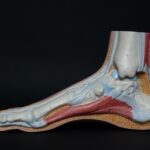Have you ever wondered how elite athletes are able to perform remarkable feats of strength, agility, and speed? Behind their awe-inspiring performances lies a crucial element that often goes unnoticed – the incredible power of tendons. These resilient fibrous tissues play a vital role in our ability to move, providing strength, stability, and flexibility to our musculoskeletal system. In this article, we will delve into the fascinating world of tendon function and unlock the secrets to optimizing performance and preventing injuries. Get ready to discover the untapped potential within your own tendons and unleash your athletic prowess like never before.

Tendon Function
Tendons play a crucial role in our ability to move and perform various physical activities. They are the tough, flexible connective tissues that connect muscles to bones, enabling the transfer of forces from the muscle to the bone to produce movement. In essence, tendons act as levers, working in tandem with muscles to move bones as they contract and expand. As a seasoned physical therapist with extensive knowledge and experience in the field, I have witnessed firsthand the essential function of tendons in maintaining musculoskeletal health and optimizing performance.
One remarkable aspect of tendons is their strength and stiffness compared to muscles. Tendons are capable of withstanding large forces and are designed to handle immense loads. For instance, the flexor tendons in the foot have the remarkable ability to handle more than eight times the body weight. This incredible strength is a testament to the importance of tendons in our daily activities and athletic pursuits.
Tendons have two distinct attachments: origins and insertions. Proximally, tendons attach to the muscle fibers, allowing for coordinated movement. Distally, tendons attach to the bones, ensuring the transfer of force generated by the muscle contraction. This intricate connection between muscles and bones is what enables us to perform a wide range of movements, from walking and running to complex athletic maneuvers.
The structure of tendons is also fascinating. Tendons are primarily composed of dense regular connective tissue, which provides the necessary strength and integrity. Within this connective tissue, tendon cells called tenocytes play a critical role in synthesizing the tendon’s extracellular matrix. This matrix is rich in collagen fibers, which give tendons their impressive strength and elasticity.
Collagen fibers in tendons are made up of different types of collagen, including type I, II, III, IV, V, and X. These collagen fibers coalesce into macroaggregates, forming fibrils, fascicles, and ultimately, tendon fibers. This intricate arrangement of collagen fibers ensures the durability and stability of tendons, allowing them to withstand the immense forces they encounter during movement.
To anchor tendons firmly to bones, they are connected by Sharpey’s fibers. These specialized collagen fibers penetrate into the bone, establishing a strong attachment that prevents the tendon from detaching during movement. This anchorage is crucial for efficient force transmission and optimal movement.
While tendons are remarkable structures, they are not invulnerable to injury. Overuse, trauma, or age-related degeneration can lead to various forms of tendinopathies or tendon injuries. Common examples include Achilles tendinopathy, tennis elbow, and rotator cuff tears. These injuries can significantly impact our ability to perform and may require specialized rehabilitation programs to restore tendon function and promote recovery.
Understanding the intricacies of tendon function is vital for optimizing performance and preventing injuries. By incorporating exercise science principles and evidence-based rehabilitation programs, physical therapists and other healthcare professionals can develop tailored treatment plans to address tendon-related issues effectively.
In conclusion, tendons are essential components of our musculoskeletal system, enabling us to move and perform everyday activities. Their strength, stiffness, and connection between muscles and bones make them invaluable in optimizing performance and maintaining overall musculoskeletal health. By unraveling the power and intricacies of tendon function, we can unlock our potential and achieve optimal performance. So let’s dive deeper into the world of tendons and explore their remarkable functions for a better understanding of our bodies.
Tendons are fascinating structures in our bodies that play a critical role in our everyday movements. Have you ever wondered about the incredible facts about tendons? Well, look no further! We have compiled a comprehensive list of facts about tendons that will leave you amazed. From their remarkable strength to their ability to withstand immense pressure, tendons truly are marvels of nature. So, if you’re curious to learn more about these remarkable connective tissues, click here for a captivating exploration of the facts about tendons: facts about tendons. Prepare to be astounded by the wonders of our incredible bodies!
Tendon Function
Tendons are an integral part of our body’s structure and function. They play a crucial role in the transmission of forces, ensuring that our muscles can effectively move our bones. But, have you ever wondered about the importance of caring for tendons? Taking care of these connective tissues is essential for maintaining overall musculoskeletal health. Whether you are an athlete or just someone looking to stay active, understanding the value of tendon care is vital.
To appreciate the significance of caring for tendons, let’s delve into the intricate workings of our musculoskeletal system. Our tendons are responsible for transmitting forces from our muscles to our bones, allowing us to perform various movements. Without healthy and well-maintained tendons, the efficiency of force transmission can be compromised, resulting in reduced strength and mobility.
If you’re curious to learn more about the transmission of forces by tendons and how it relates to overall physical performance, click here. Through this link, you can gain a deeper understanding of the mechanics behind force transmission and discover practical tips for ensuring your tendons stay in top shape. By investing a few minutes of your time, you’ll unlock valuable insights that can help you optimize your fitness journey.
Remember, knowledge is power, especially when it comes to caring for your body. Click here to explore the importance of caring for tendons and take the first step towards achieving your optimal physical performance. Your tendons will thank you!
To learn more about the importance of caring for tendons, click here. For a comprehensive understanding of the transmission of forces by tendons, click here.
Tendon Structure and Function: Exploring the Role of Tendons in the Body
[youtube v=”AULT0tfBhKA”]
Why Are Tendons Essential for Everyday Movements?
Tendons play a crucial role in our bodies by connecting muscles to bones, allowing us to perform a wide range of movements. They act as a strong and stiff bridge between muscles and bones, transferring the force generated by the muscles to the bones. This helps us avoid injuries and enables us to engage in various activities, including sports.
The Anatomy of Tendons: Collagen as the Foundation
Tendons are predominantly composed of collagen, a protein that makes up around 95% of their structure. Collagen provides the tendons with strength and elasticity, allowing them to withstand significant forces. The specific type of collagen found in tendons is mainly type 1 collagen, which makes up approximately 85-87% of the tendon’s dry mass. This collagen gives tendons their remarkable ability to handle immense loads.
Delving into Tendon Structure: From Fibers to Macroaggregates
Tendons are structured in a fascinating way, with various components working together to provide strength and flexibility. They consist of smaller clusters of collagen fibers, which progressively coalesce into larger arrangements. This unique system minimizes friction between the fibers, allowing them to glide smoothly and bear more force. As a result, tendons boast an impressive structural integrity.
The Role and Functions of Tendons
The primary function of tendons is to transmit forces from muscles to bones, ensuring coordinated movement throughout our body. By efficiently transferring the force generated by muscles, tendons not only enable smooth movements but also help in preventing injuries. They act as a safeguard, protecting the body from damage during physical activities.
Tendon Vulnerability: Tendinopathies and Causes
While tendons are incredibly robust, they can still be susceptible to injuries. Overuse, trauma, or age-related degeneration can lead to tendinopathies or tendon injuries. Tendinopathies, such as tendonitis or tendinosis, occur when repetitive movements strain the tendon, causing collagen breakdown and weakening. This can result in pain and limited movement in the affected area.
The Importance of Understanding Tendon Function
Understanding the function of tendons is vital for optimizing performance and preventing injuries. By gaining insight into how tendons work, individuals can implement strategies to improve their overall musculoskeletal health and enhance their athletic abilities. Additionally, specialized rehabilitation programs may be necessary when recovering from tendon injuries to restore strength and mobility.
In conclusion, tendons serve as the crucial link between muscles and bones, allowing us to perform everyday movements and engage in physical activities. Their composition, predominantly made of collagen, provides tendons with exceptional strength and elasticity. By comprehending the structure and function of tendons, we can better appreciate the essential role they play in maintaining our body’s health and functionality.
Remember, taking care of your tendons is essential to keeping your body in optimal condition, particularly for athletes who heavily rely on these vital structures. Whether you’re a professional athlete or simply a fitness enthusiast, ensuring the well-being of your tendons is fundamental for achieving peak performance and overall well-being.
FAQ
Question 1
What is the function of tendons?
Answer 1
Tendons serve the purpose of transmitting forces generated from muscles to the bone, enabling movement. They essentially work as levers to move bones as muscles contract and expand.
Question 2
Why are tendons important in maintaining musculoskeletal health?
Answer 2
Tendons are crucial for movement as they connect muscles to bones, allowing for coordinated and efficient motion. They play a vital role in maintaining musculoskeletal health by facilitating proper biomechanics and joint stability.
Question 3
What is the composition of tendons?
Answer 3
Tendons are made up of dense regular connective tissue. They consist of collagen fibers, which are synthesized by tendon cells called tenocytes. Different types of collagen, such as type I, II, III, IV, V, and X, are present in tendons.
Question 4
How do tendons withstand high forces?
Answer 4
Tendons are incredibly strong and can handle significant amounts of force. The collagen fibers in tendons coalesce into macroaggregates and form fibrils, fascicles, and tendon fibers, which contribute to their ability to withstand and transmit forces.
Question 5
What can happen if tendons are injured?
Answer 5
Injuries to tendons can result in various forms of tendinopathies or tendon injuries. These can include conditions such as tendinitis, tendinosis, and tendon tears. Proper diagnosis and treatment are crucial for optimal recovery and restoration of tendon function.
- China II Review: Delicious Food & Speedy Service - April 17, 2025
- Understand Virginia’s Flag: History & Debate - April 17, 2025
- Explore Long Island’s Map: Unique Regions & Insights - April 17, 2025
















